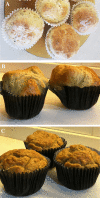Development of muffins as dialysis snacks for patients undergoing hemodialysis: results of chemical composition and sensory analysis
- PMID: 32860211
- PMCID: PMC8357674
- DOI: 10.1007/s40620-020-00831-z
Development of muffins as dialysis snacks for patients undergoing hemodialysis: results of chemical composition and sensory analysis
Abstract
Objective: This study aimed to develop two non-industrial food products as financially accessible options to prevent and treat malnutrition in hemodialysis (HD) patients. These food products were developed and intended for use as dialysis snacks.
Methods: This is a cross-sectional and multi-step study. First, 183 adult HD patients (55 ± 14 years; 50.8% males), replied to a questionnaire with their food preferences regarding taste (salty, sweet, bitter, sour) and consistency (liquid, solid, pasty) for a dialysis snack. Most patients preferred a food product with a solid consistency (90%) and a salty flavor (81.4%). Second, three muffin formulations of fine herbs were developed; one enriched with whey protein concentrate (WPC), a second with textured soy protein (TSP) and a third standard formulation without protein for comparison with the protein-enriched muffins, for which the chemical and nutritional compositions were analyzed. In the third step, 60 patients on HD (61 ± 15 years; 53% males) were enrolled in a sensory analysis by applying a 9-point structured hedonic scale, ranging from "extremely liked" (score 9) to "extremely disliked" (score 1).
Results: When compared with the standard formulation, the formulations enriched with WPC and TSP protein had a significantly higher amount of protein/serving (Standard: 5.9 ± 0.3 g vs WPC: 14.5 ± 0.9 g and TSP 10.8 ± 0.7 g; P < 0.05) but a lower amount of carbohydrate (Standard: 13.1 ± 2.2 g vs WPC: 5.6 ± 0.8 g and TSP 6.0 ± 1.2 g vs; P < 0.05). The mineral content/serving of the protein-enriched muffins was low in phosphorus (50 mg) and sodium (180 mg). The potassium content/serving was moderate for the WPC muffin (225.2 mg) and low for the TSP muffin (107.9 mg). The acceptability index (AI) for the enriched protein muffins was higher than 70% and similar to the standard formulation.
Conclusion: The muffins with fine herbs and enriched with protein were well-accepted by all patients and appropriate to serve as dialysis snacks for HD patients.
Keywords: Dialysis snack; Energy protein supplement; Hemodialysis; Protein energy wasting.
© 2020. The Author(s).
Conflict of interest statement
The study protocol was approved by the Local Research Ethics Committee (Pedro Ernesto University Hospital, Rio de Janeiro State University, number 2.259.878).
Figures


Similar articles
-
The effect of protein-enriched snacks on serum albumin concentration in non-selected haemodialysis patients.J Nephrol. 2021 Aug;34(4):1291-1299. doi: 10.1007/s40620-020-00887-x. Epub 2020 Nov 2. J Nephrol. 2021. PMID: 33136282
-
Quality characteristics and sensory evaluation of protein-rich baked snacks for adults with chronic kidney disease: a proof of concept study.J Nephrol. 2024 Jan;37(1):159-169. doi: 10.1007/s40620-023-01772-z. Epub 2023 Oct 5. J Nephrol. 2024. PMID: 37796432
-
The relative reinforcing value of sweet versus savory snack foods after consumption of sugar- or non-nutritive sweetened beverages.Appetite. 2017 May 1;112:143-149. doi: 10.1016/j.appet.2017.01.028. Epub 2017 Jan 23. Appetite. 2017. PMID: 28126491 Clinical Trial.
-
Quality Evaluation of Muffins Enriched With Blueberry and Cranberry Powders.Int J Food Sci. 2024 Aug 12;2024:7045401. doi: 10.1155/2024/7045401. eCollection 2024. Int J Food Sci. 2024. PMID: 39161744 Free PMC article.
-
Influence of Avocado Purée as a Fat Replacer on Nutritional, Fatty Acid, and Organoleptic Properties of Low-Fat Muffins.J Am Coll Nutr. 2018 Sep-Oct;37(7):583-588. doi: 10.1080/07315724.2018.1451408. Epub 2018 Apr 13. J Am Coll Nutr. 2018. PMID: 29652576
References
-
- Carrero JJ, Thomas F, Nagy K, Arogundade F, Avesani CM, Chan M, et al. Global Prevalence of protein-energy wasting in kidney disease: a meta-analysis of contemporary observational studies from the International Society of Renal Nutrition and Metabolism. J Ren Nutr. 2018;28(6):380–392. doi: 10.1053/j.jrn.2018.08.006. - DOI - PubMed
-
- Carrero JJ, Stenvinkel P, Cuppari L, Ikizler TA, Kalantar-Zadeh K, Kaysen G, et al. Etiology of the protein-energy wasting syndrome in chronic kidney disease: a consensus statement from the International Society of Renal Nutrition and Metabolism (ISRNM) J Ren Nutr. 2013;23(2):77–90. doi: 10.1053/j.jrn.2013.01.001. - DOI - PubMed
MeSH terms
Grants and funding
LinkOut - more resources
Full Text Sources
Medical
Miscellaneous

